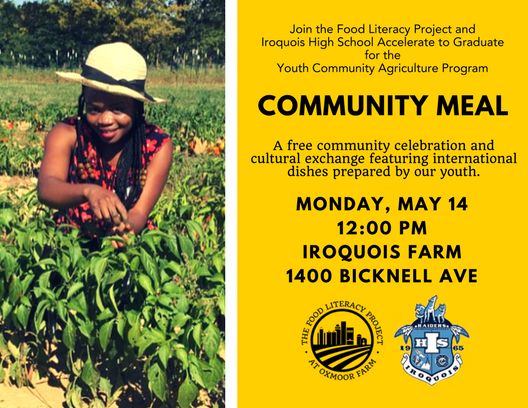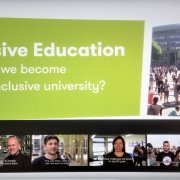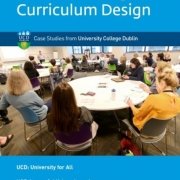Accelerate to Graduate
Excerpt
Accelerate to Graduate (A2G) program was envisioned to provide a pathway to high school graduation for immigrants and refugees who are past the traditional high school ages of 14-18, and to whom English is their Second Language (ESL). These students either do not have enough credits to graduate or are older than the traditional high school student, and are at risk for ageing out of high school.
A performance-based program, A2G, was designed to provide newcomer students with concentrated lessons in English language acquisition and core content areas such as mathematics and history. To help each student meet his or her essential standards, he or she receives a personalized learning plan. Each student has a list of courses and credits needed to graduate, and teachers group students together to work on common courses. Students also get a daily “Power Hour,” a time for both independent work and collaboration with teams for projects and presentations. By focusing students on meeting prescribed standards, they can earn credits faster than usual. The key to the program is that once students meet the essential standards for core content classes, they complete the course and are enrolled in additional courses without having to wait for the next semester.
Narrative, origins and objectives of the initiative
What kind of project is this? Please give a short description (summary) of it.
Accelerate to Graduate is a piloted program at Iroquois High School in Louisville, KY, USA. It targets English language learners at-risk for aging out of high school. It utilizes sheltered, blocked scheduling to expedite credit completion by a team of ESL (English as Second Language) educators.
Please tell us why, in general, this project is considered a successful one?
Accelerate to Graduate is considered successful because it implements needed interventions towards an at-risk, marginalized population of English Language Learners. Prior to the project, older English Language learners with limited or interrupted formal education in danger of aging out of high school were missing from the district’s priority student categories. Since the project’s start, awareness and acknowledgement of the dearth of such students’ unique academic needs are gaining prominence and recognition.
And why would you consider it a grass-roots initiative?
Accelerate to Graduate is a grass-roots initiative originating at school level. The pilot is a result of teachers and administrators identifying the urgency for older students to earn high school course credits leading to a diploma, before required to exit the secondary school due to their advanced ages. The Principal of the school and the administrator of ESL programs for the school district provided resources and staff to launch the pilot in one school. Already in its second year, this initiative is the first of its kind in the entire school district.
What challenges needed to be solved in this project?
How might educators engage and support the distinct academic and psycho-social needs of students at risk for aging out of high school with limited prior schooling? In addition, to what extent can expedited academic curricula and standards attainment be expected of unique learners? What does such a model look like in the classroom?
Is this initiative based on any particular theoretical framework? Which one?
No, it is not based on one theoretical framework. It incorporates a project-based learning instructional framework influenced by a constructive learning theory.
(Appendix) Is your intervention standing on its own or is it a part of a bigger and more holistic approach?
Intervention is a component of Jefferson County Public Schools' Deeper Learning approach. The project has the potential to spread to other schools and impact different students.
Please describe the group(s) intended as beneficiaries of this initiative
Why has this group (have these groups) been chosen?
A2G students are classified as at-risk for several factors. Most students are newcomers to the U.S. as refugees, asylum seekers, immigrants, or undocumented individuals. The majority of students experience an interrupted or limited formal education, might be preliterate in their first language, and/or could be several years behind in math and reading of similar-aged peers. At not fault of their own, students might have large, frequent gaps in schooling and have lost years in the classroom. As a result, students are at risk for aging out of high school, as individuals cannot enroll past the age of 21. In addition, students are adolescents and young adults entering a new country context in formidable years of development. Many students harbour basic English communication skills and lead their families through government documents, acting as a chauffeur, and translating in a multitude of situations. For all of the aforementioned factors, A2G students are a high risk for leaving high school and never receiving a high school diploma.
Could you please tell us something about the relative size of the (of each) target group, within the school/university population, region and/or country?
Jefferson County Public Schools (JCPS) is the 27th largest school district in the U.S. The district has 150 schools and more than 100,000 students. Of the total student population, 8,000 English Language Learners (ELLs) are positioned in 43 elementary, middle, and high schools offering English as Second Language (ESL) program services.
Which social characteristics are taken into account and what is the geographical area covered?
Immigrant and refugee students who were older than traditional high school students – or in danger of aging out of high school (they must leave school by 21 years of age).
On which level is the project implemented?
Immigrant and refugee students who arrive in the United States as older students, or those who have not been successful at the transition to tradition learning in the USA.
Please describe the political and socio-economic factors that you believe have been important enablers for your initiative
Did the initiative have political support?
The school district, Jefferson County Public Schools, is supportive of the innovative approach of A2G. The State of Kentucky education guidelines are being adhered to.
How did it fit with local, regional or national policies?
The city of Louisville has a large population of immigrants and refugees. This program is contributing to a larger plan to prepare students for the workforce, and higher education.
Who are the stakeholders supporting the initiative?
Jefferson County Public Schools, the school district for this county. The students and their parents and the community at large.
Are there particular demographic changes present that are influencing the project?
This program is influenced by the influx of immigrants and refugees who are older teenagers and may not have the opportunity to graduate from high school. People have settled in Louisville from numerous countries from all over the continent of Africa, the continents of South and Central America, as well as North America and Asia.
What is the institutional strategy and culture of the (educational) organization?
This program focuses on English learners and teaching English, as well as content from Social Studies, History, Math, Sciences, and traditional high school courses.
To what extent does the initiative have an influence on institutional policy (or potential influence) of the (educational) organization?
The program is in the pilot/early stages. Currently the program is informing long-term planning regarding serving students who are at a disadvantage of leaving school before earning a diploma. This includes students who are native English speakers.
(Appendix) Is there public support for your initiative and the issue it addresses?
The school district, the school administration and those in the Kentucky Department of Education support this initiative. The program is addressing district-wide issues of gaps in graduation rates.
(Appendix) What other factors do you think have been important for the success of this initiative?
The program success relies on the close collaboration of the teachers and the team. Importantly, the integration of community partnerships and field trips and real world interactions is critical for students’ comprehension of the content learning standards.
Please describe the overall initiative design and the methods and tools used to reach the goals
Please describe the specific activities carried out.
This program relies on teams working together. Three teachers are assigned to a cohort of students. One teacher is responsible for History/Social Sciences, Maths and English. The additional content classes are taught by certified teachers in those fields.
The schedule is set by the teachers to address accommodating instructional time, project creation, field trips, speakers and visitors, assessments and other factors. The schedule is somewhat fluid due to being one cohort of students. As the program grows there would be a need to examine a schedule to work for multiple teaching teams and cohorts.
What were the key roles (teacher, student, management team etc.) within the project?
Student as an autonomous and active agent in their learning of content material and course completion. Teachers collaborate with one another to craft lessons that are cross-curricular, including standards from several areas.
What ideas, tools, theories, models, methodology (etc.) have been used to reach the goals?
Project-based learning, Standards-based learning, Performance-based learning, Personalized learning, Deeper learning, Cross-curricular teaching, Team teaching.
What are the final revenues of the project?
N/A
Please describe if your project ensured its sustainability
If so, how did you ensure the short-term impact of the project?
This program is currently teaching the second cohort for the 2018-2019 academic year. We anticipate this program or a similar program to continue into the 2019-2018 year. We would then have three years of data on three unique cohorts to evaluate and assess how to proceed.
And how did you ensure the long-term impact of the project?
The long-term impact is currently difficult to assess. In the short term, approximately one third of graduates from the 2017 – 2018 cohort have enrolled in university courses and are experiencing success in the first semester. College attendance rates, drop-out/completion rates and employment rates would track long-term impacts.
Has your project been replicated elsewhere?
A high school that enrolls newcomers, those in the USA schools for fewer than two years, is exploring the initiative. This began in September 2018 and is operating independently, without collaboration with the A2G program. No information is available to report on this.
Please tell us about the resources used in this initiative
What was the budget for the initiative?
The project is consumed within the budget for the entire school and specific support from the school district. Items that are provided by the District are the salaries of three teachers and 40 Chromebooks and two Chromebook charging carts. Classrooms, furniture, textbooks, and instructional supports are provided by the school in Iroquois. Community partners donate staff time and waive entry fees for field trips and community projects. At present there is no designated line item for this project as a new initiative.
How much did the initiative depend on volunteers?
The program does not rely on volunteers.
How were the costs perceived by the public/the sector/other stakeholders?
Funds are part of the annual school budget.
To what extent did the initiative achieve its objectives?
Please describe the evidence to support the success of your initiative.
The graduation rate of students in the first cohort speak to the success of the initial cohort. Of the 40 students first identified to participate, 28 graduated in 2017-2018 and three are projected to graduate in 2018-2019. Of that group, two dropped out, and the others moved away.
Did the intervention lead to any unintended (positive) outcomes?
Increased psycho-social support of students due to learning in a sheltered, culturally-responsive learning environment led by ESL educators. The students have often report past trauma, and this cohort model allows students to develop relationships that positively affect instruction, behavior and attendance.
What indicators (quantitative and qualitative) have you measured to demonstrate success?
Quantitative measures include the 2017-2018 A2G student cohort graduation rate of 92%. Qualitative measures include semi-structured empathetic interviews with students at the start of the year. Classroom observations of students prior to their enrollment in A2G and after their completion of the A2G program. Students also present a Graduate Profile, a presentation of the work they completed and an assessment of what they have learned. This is a school district requirement, as well as a digital backpack for collection of work samples. In addition students are required by state law to sit for a Citizenship Assessment – as are all native born students as well. The A2G students are to date at a 89% passing rate and the other students must test or retest to pass. The overall school population is at a 77% passing rate.
(Appendix) How did you evaluate/monitor this intervention?
The initiative may be evaluated in several ways:
Credit completion, graduation rates, English reading and writing scores as demonstrated on WIDA ACCESS Assessment. Also the college acceptance and enrollment of students in the first cohort.








